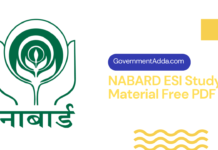Q.1) Which of the following are the features of the Contractionary (Restrictive) fiscal policy?
1. It is usually followed in the times economic boom/inflationary times.
2. It leads to an increase in the money supply.
3. Government reduces expenditure and increases taxes.
4. When this restrictive fiscal policy is followed by the government, it usually cuts up on the aggregate demand and thus the economic growth.
[a] 1, 2 and 3
[b] 1 and 4
[c] 2 and 3
[d] 1, 3 and 4
e] 1, 2, 3 and 4
Q.2) The Ministry of Social Justice and Empowerment has launched a project to make 100 websites of various State Governments/UTs accessible to persons with disabilities (Divyangjans) under Accessible India Campaign. What is the name of the project?
[a] Internet Accessibility Project
[b] Website Accessibility Project
[c] Darpan
[d] Narrowing Digital Divide Project
[e] Sparsh
Q.3) Which of the following are the proposed milestones under the ‘Sugamya Bharat Abhiyan’?
[a] At least 50% of all the government buildings of National Capital and all the State capitals will be made fully accessible for persons with disabilities by July 2018.
[b] Ensuring that 50% of railway stations in the country are converted into fully accessible railway stations (March 2018).
[c] Ensuring that 25% of Government owned public transport carriers in the country are converted into fully accessible carriers (March 2018).
[d] Ensuring that 25% of all public television programmes aired by government channels meet these standards (March 2018).
[e] All the above
Q.4) Which of the following is/are correct with regard to a ‘Totalitarian economy’?
1. Public sector alone functions in this type of planning. Government has full and direct control.
2. It is a rigid planning. People can be pressurized by the government for the achievements of the plan-targets.
3. There is complete economic freedom and all economic decisions are taken by the people.
4. People’s welfare can be sacrificed at the altar of rapid economic development of the country. Minimum needs of the people alone are catered to.
[a] 1, 2 and 4
[b] 2 and 3
[c] 1 and 4
[d] 1, 3 and 4
[e] 1, 2, 3 and 4
Q.5) Which of the following days is celebrated as ‘International Day of Persons with Disabilities’?
[a] 10th December
[b] 3rd December
[c] 8th December
[d] 15th December
[e] 21st December
Q.6) In November 2017, WHO for the first time released guidelines on responding to victims of sexual abuse. Which section of the society did the guidelines specifically cater to?
[a] Women
[b] Transgenders
[c] Children and adolescents
[d] Refugees
[e] None of the above
Q.7) Which of the following is/are incorrect with regard to the ‘Proportional Tax’ and ‘Regressive Tax’?
[a] Proportional Tax is a type of tax that takes the same percentage of income from all income groups.
[b] Regressive Tax is a tax that takes a larger percentage of income from low-income groups than from high-income groups.
[c] GST is an example of Regressive Tax and Corporate Tax is an example of Proportional Tax.
[d] All the above
[e] None of the above
Q.8) Which of the following state assemblies has recently passed a bill to give 5% reservation to the Kapu community in education and employment sectors?
[a] Karnataka
[b] Andhra Pradesh
[c] Kerala
[d] Odisha
[e] Maharashtra
Q.9) The Protection of Civil Rights Act was enacted in which of the following years?
[a] 1965
[b] 1987
[c] 1945
[d] 1962
[e] 1955
Q.10) As per Census 2011, what is the differently-abled population in India?
[a] 26.8 million
[b] 30.7 million
[c] 29.7 million
[d] 41.7 million
[e] 18.6 million
ANSWER:-
1)[d] 1, 3 and 4
2) [b] Website Accessibility Project
3)[e] All the above
4)[a] 1, 2 and 4
5)[b] 3rd December
6)[c] Children and adolescents
7) [e] None of the above
8)[b] Andhra Pradesh
9)[e] 1955
10)[a] 26.8 million











